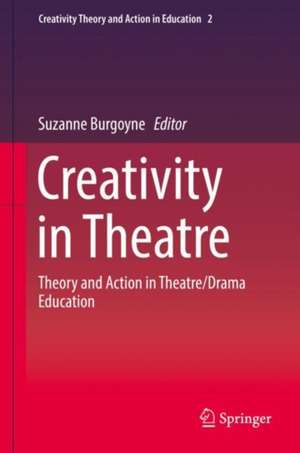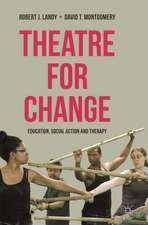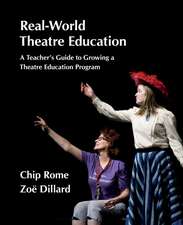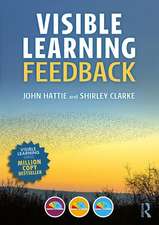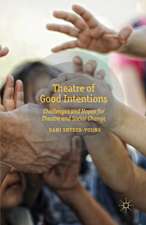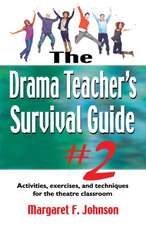Creativity in Theatre: Theory and Action in Theatre/Drama Education: Creativity Theory and Action in Education, cartea 2
Editat de Suzanne Burgoyneen Limba Engleză Hardback – 4 oct 2018
The purpose of this volume is to bridge the interdisciplinary abyss between the study of creativity in theatre/drama and in other fields. Sharing theories, research findings, and pedagogical practices, the authors and I hope to stimulate discussion among creativity and theatre scholar/teachers, as well as multidisciplinary research.
Theatre educators know from experience that performance classes enhance student creativity. This volume is the first to bring together perspectives from multiple disciplines on how drama pedagogy facilitates learning creativity. Drawing on current findings in cognitive science, as well as drama teachers’ lived experience, the contributors analyze how acting techniques train the imagination, allow students to explore alternate identities, and discover the confidence to take risks. The goal is to stimulate further multidisciplinary investigation of theatre education and creativity, with the intention of benefitting both fields.
| Toate formatele și edițiile | Preț | Express |
|---|---|---|
| Paperback (1) | 736.32 lei 38-44 zile | |
| Springer International Publishing – 21 dec 2018 | 736.32 lei 38-44 zile | |
| Hardback (1) | 746.98 lei 38-44 zile | |
| Springer International Publishing – 4 oct 2018 | 746.98 lei 38-44 zile |
Preț: 746.98 lei
Preț vechi: 982.87 lei
-24% Nou
142.95€ • 148.69$ • 118.02£
Carte tipărită la comandă
Livrare economică 10-16 aprilie
Specificații
ISBN-10: 3319789279
Pagini: 290
Ilustrații: XV, 287 p. 22 illus., 8 illus. in color.
Dimensiuni: 155 x 235 mm
Greutate: 0.64 kg
Ediția:1st ed. 2018
Editura: Springer International Publishing
Colecția Springer
Seria Creativity Theory and Action in Education
Locul publicării:Cham, Switzerland
Cuprins
Part I Are Actors Creative?.- 1. The Actor’s Real Role on the Production Team. Tony Noice and Helga Noice.- 2. Creative Acting. Robert Barton.- Part II Activities for Teaching Creativity.- 3. The Improv Paradigm: Three Principles that Spur Creativity in the Classroom. Clayton D. Drinko.- 4. Dreamwork for Dramatic Writing: An Organic Approach to Magic and Creativity. David A. Crespy.- 5. Performative Embodiment as Learning Catalyst: Exploring the Use of Drama/Theatre Practices in an Arts Integration Course for Non-Majors. Kathryn Dawson.- 6. Creativity, Intimate Publics and the Proxemics of Pop Up Poetry Performance. Anne Harris and Stacy Holman Jones.- 7. Reforming Theatrical Education from its Extrovert-based Model. Rob Roznowski.- 8. Teaching the Creative Process: An Essential and Portable Skill. Lynne Porter.- Part III Creating the Self.- 9. Staging Our Selves: Towards a Theory of Relationality, Possibility, and Creative Youth Selfhood. Kathleen Gallagher and Scott Mealey.- 10. A Vygotskian Argument for Teaching Drama in Secondary Schools. Harry Daniels and Emma Downes.- 11. Creativity and the Cybernetics of Self: Drama, Embodied Creation and Feedback Processes. Susan Davis.- Part IV Drama, Theatre, Therapy, Creativity.- 12. Psychodrama and Creativity in Education. John Nolte.- 13. Reconnecting Learning to Development through Performance Ensembles. Carrie Lobman.- Part V Crossing Disciplinary Boundaries.- 14. Enhancing Creativity with Neurofeedback in the Performing Arts: Actors, Musicians, Dancers. John H. Gruzelier.- 15. Creativity Theory and Action in Bioengineering Class. Ferris M. Pfeiffer, Suzanne Burgoyne, Heather K. Hunt, Johannes Strobel, Rachel E. Bauer, Jennie J. Pardoe, Simonita Perales Simkins, Mary Elaine Vansant, Joshua Saboorizadeh, Kate Busselle, William Palmer.- Part VI Assessment.- 16. Assessing Creativity as a Student Learning Outcome in Theatre Education. Marcelo Schmidt and Mark Charney.
Textul de pe ultima copertă
People who don’t know theatre may think the only creative artist in the field is the playwright--with actors, directors, and designers mere “interpreters” of the dramatist’s vision. Historically, however, creative mastery and power have passed through different hands. Sometimes, the playwright did the staging. In other periods, leading actors demanded plays be changed to fatten their roles. The late 19th and 20th centuries saw “the rise of the director,” in which director and playwright struggled for creative dominance. But no matter where the balance of power rested, good theatre artists of all kinds have created powerful experiences for their audience.
The purpose of this volume is to bridge the interdisciplinary abyss between the study of creativity in theatre/drama and in other fields. Sharing theories, research findings, and pedagogical practices, the authors and I hope to stimulate discussion among creativity and theatre scholar/teachers, as well as multidisciplinary research. Theatre educators know from experience that performance classes enhance student creativity. This volume is the first to bring together perspectives from multiple disciplines on how drama pedagogy facilitates learning creativity. Drawing on current findings in cognitive science, as well as drama teachers’ lived experience, the contributors analyze how acting techniques train the imagination, allow students to explore alternate identities, and discover the confidence to take risks. The goal is to stimulate further multidisciplinary investigation of theatre education and creativity, with the intention of benefitting both fields.
Caracteristici
Descriere
People who don’t know theatre may think the only creative artist in the field is the playwright--with actors, directors, and designers mere “interpreters” of the dramatist’s vision. Historically, however, creative mastery and power have passed through different hands. Sometimes, the playwright did the staging. In other periods, leading actors demanded plays be changed to fatten their roles. The late 19th and 20th centuries saw “the rise of the director,” in which director and playwright struggled for creative dominance. But no matter where the balance of power rested, good theatre artists of all kinds have created powerful experiences for their audience.
The purpose of this volume is to bridge the interdisciplinary abyss between the study of creativity in theatre/drama and in other fields. Sharing theories, research findings, and pedagogical practices, the authors and I hope to stimulate discussion among creativity and theatre scholar/teachers, as well as multidisciplinary research.
Theatre educators know from experience that performance classes enhance student creativity. This volume is the first to bring together perspectives from multiple disciplines on how drama pedagogy facilitates learning creativity. Drawing on current findings in cognitive science, as well as drama teachers’ lived experience, the contributors analyze how acting techniques train the imagination, allow students to explore alternate identities, and discover the confidence to take risks. The goal is to stimulate further multidisciplinary investigation of theatre education and creativity, with the intention of benefitting both fields.
